I received my copy of the new RSV-2CE Large Print Thinline from Catholic Bible Press. I wanted to share some initial pictures with you. Overall, it truly exceeds my expectations. The size is comparable to the ESV-CE from Augustine and the Ignatius Press RSV-2CE. The print is larger than those two and darker, which I appreciate. This is really an exceptional edition of the RSV-2CE and could serve as the perfect sidekick of a certain large study bible that was just released. This Bible is printed in India.
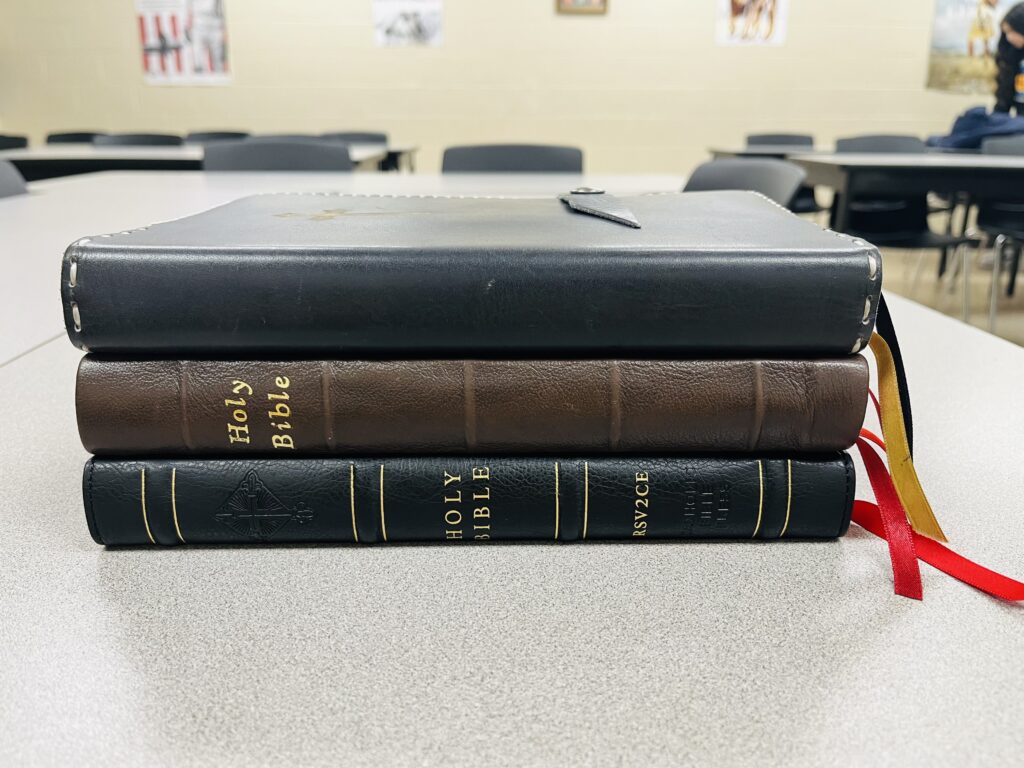

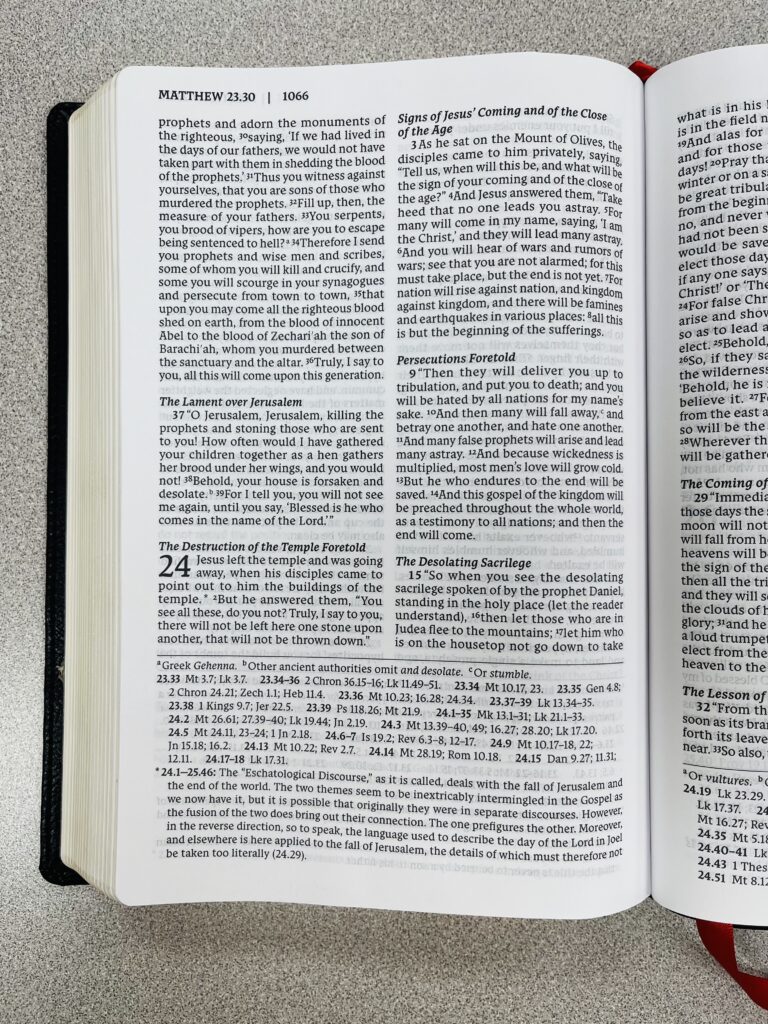
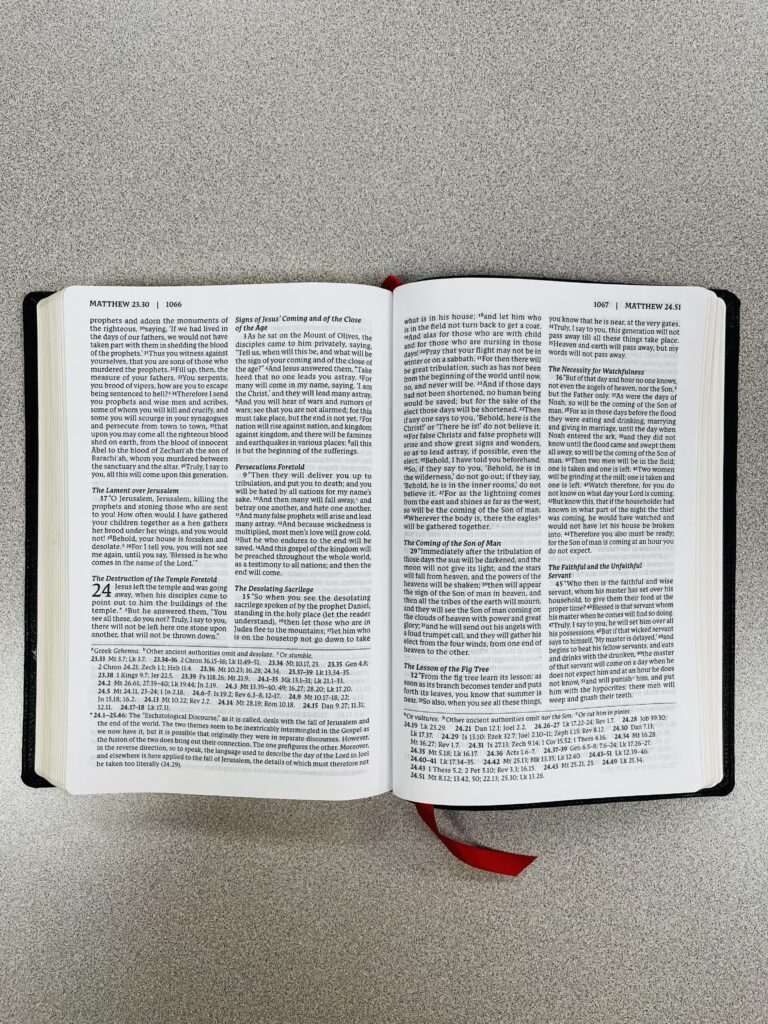
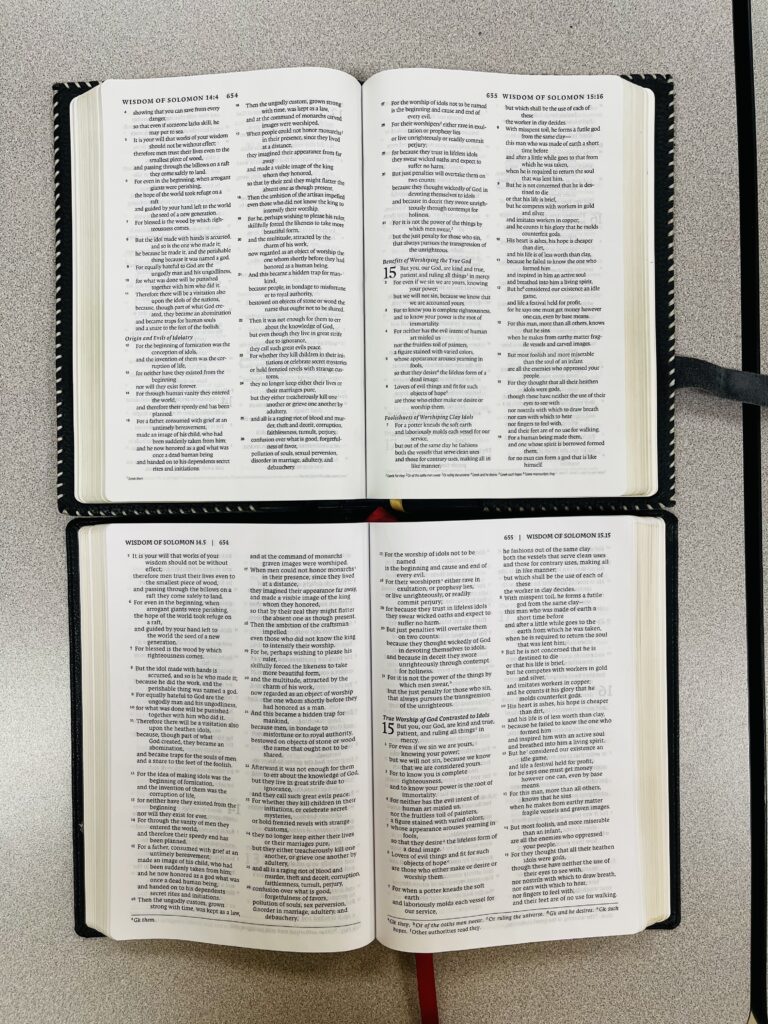
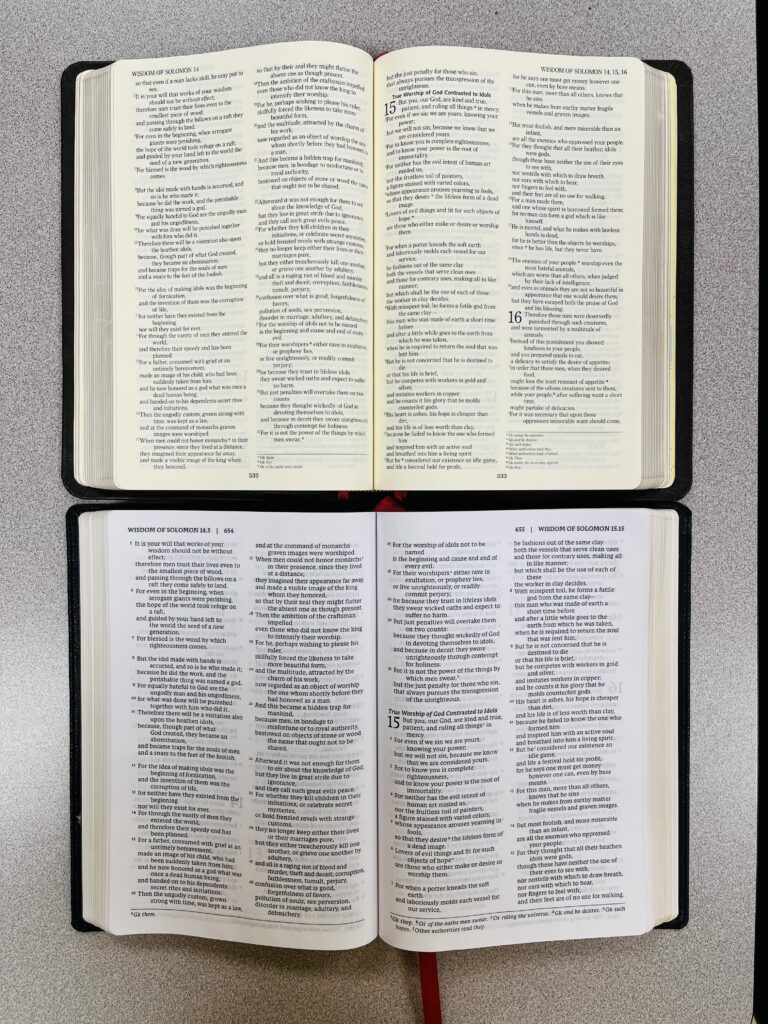

Looks very nice!
I am not a fan of how they did the foot notes. Having the references in between Translation footnotes and commentary make it look clunky.
Well at least they’ve improved upon the mulchy yellow paperstock Ignatius uses. Still I have to wonder: who is this edition for? Like, who is buying CBP Bibles looking for a -2CE that hasn’t already gotten a copy of Ignatius’? There’s no new study material or footnotes (Like Ascension’s “Great Adventure”). I mean at least CBP’s NRSV-CE makes sense for Canadian readers and it’s NABRE for Catholics in the US. Following that reasoning, is this to capture the Ordinariate market? The Antilles?
I’m done with this “translation.” Like the ESV-CE, it’s just throwback warmover of 20th Century translation built on obsolete 20th Century scholarship and textual traditions. From here out my money’s on translations made this century: RNJB, whatever Mary Sperry’s translation will be called, and (God willing) the NRSVue-CE.
The yellow paper is intentionally sought after and is meant to reduce eye strain
I love the yellow paper in my IP study bible: it’s easy on the eye, feels beautiful and the pages are very easy to turn. I also have CBP Illustrated bible and that paper is lovely as well.
I fear this response is hysterical and not reasonable. The Catholic community in the Anglophone region has never been so well served as it is today, certainly with the RSV 2CE and the ESV CE; thank God for both. These are accurate, scholarly and most reliable. Charity causes me to pass over the NRSV; a ghastly and tragic betrayal of the RSV tradition, and unworthy of that great name.
Is this edition line matched? It appears to be from the photos. With the darker font how is the ghosting between pages compared to the other two? Thx Tim.
Yes. It is line matched.
Gil,
Ghosting is also not a huge issue. With the font and line matching, I have no issues with reading it.
Is this a sewn binding?
Yes, it is sewn.
I’m glad to see that the RSV-2CE is getting some more love, especially from a major publisher. This looks like a very nice edition. I’m not interested in purchasing it, since I already have Ignatius’ basic RSV-2CE, but I’m glad that this new publication is available.
This does look very nice. I appreciate the slightly larger font and the line matching. It looks like a great reading bible.
One other thing I was thinking about in regards to this edition is that you will more likely see this edition of the RSV-2CE in a store like Barnes and Noble than most of the other editions available. That is an important thing to remember. CBP bibles are the main Catholic editions that I am currently seeing in larger retail stores, thanks to it being an imprint of HarperCollins.
Nice to have this translation in a proper format. I got rid of my ignatius years ago because I hated the margins and the paper.
With this coming out at the same time as the Ignatius Study Bible (and me monitoring the blog more often since I wrote my first article in a while) I am reminded of that Lenin quote: there are decades when nothing happens and weeks when decades happen.
I work at a school where we use the RSV-2CE. This looks like a minor step up in terms of personal reading. Maybe I will get one in the future, but I mostly read NJB-RNJB now, plus Knox and DR for that Vulgate fix.
This is my dream Bible!
I was wondering though if, considering the ESV-CE is now available, if the ESV-CE is preferable to the RSV-2CE?
Personally, I can’t really find any place where I strongly prefer the ESV to the 2CE except for the choice of Greek manuscript for Tobit. The ESV reverts to older scholarship (Masoretic Text preference) in the OT, and relegates most Septuagint and Dead Sea Scroll readings to the footnotes (with a handful of exceptions such as Deut 32:43). The New Testament is slightly more literal in some places than the 2CE, and slightly more “Evangelical” in other places, but is generally indistinguishable from the 2CE. And, it has some really weird renderings, even beyond the infamous ones (such as the head-scratchingly idiosyncratic Isaiah 53:1, which matches no other English translation). And, while I’m somewhat wary about de-gendered language, the ESV does the opposite and seems to write women (including the Blessed Mother!) out of Scripture in many places where the Greek doesn’t call for it (Romans 12:7-8, Romans 16:1,7, John 2:4, and several others). I tried to spend time with the ESV-CE and learn to like it, and I kind of ended up hating it.
I agree. I’ve repeatedly tried to give the ESV another chance, but every single time I again go over the ESV vs. NRSV and ESV vs. RSV analysis material I’ve collected, I remember why I dislike the ESV compared to the other options. If you’ve got the RSV-2CE, NRSV-CE, and several other translations to compare each other with, then 9 times out of 10 the RSV-2CE is perfectly fine to keep as one’s primary Bible translation, even if it’s a 20-year-old tweak of a 60-year-old edition of the RSV. Whenever Augustine Institute finishes its CSV, I’m sure that, inevitable flaws and all, will fulfill whatever purpose the ESV-CE would have for me, since I’m not in a country adopting the ESV-CE for its lectionary.
The ESV is vastly superior to any edition of the RSV or NRSV because it doesn’t go off into wild flights of fancy in translating the OT the way the RSV/NRSV often does. The RSV and NRSV claim, in literally hundreds of places in the OT, that “The meaning of the Hebrew is unknown,” and then they make something up with no basis on anything. The ESV doesn’t use this crutch, and in the handful of places where it is true that no one knows what the Masoretic text means, the ESV doesn’t make something up but rather takes a reading from the Septuagint, or the Vulgate or the Targums or the Dead Sea Scrolls, or one of the numerous other ancient versions, and then clearly indicates in the footnotes that they have done and offers a probable translation of the Masoretic text., This is a preferable metholodolgy.
Thank you all for responding! I’m still going back and forth on which translation to pick. On one hand, The ESV-CE Is going to be the translation used at the liturgy and it’s also more up-to-date than the RSV-2CE, but on the other hand the RSV-2CE is more widely used for some of the best Catholic study Bibles, there’s better editions, etc. The print on the ESV-CE Bibles I’ve perused is hard on my eyes; plus, from what I understand Crossway refuses to allow an ESV-CE study Bible or commentary to be included in the text. So even if it’s going to be used in the lectionary it just doesn’t seem like, at this time, there’s much of a future for it.
Honestly, I think itś a Coke vs. Pepsi debate, and every person will have a different opinion based on their experiences with those translations. One thing we can all agree on is that they both beat the NABRE
Yeah, to be fair, I’d recommend either to almost anyone. Pardon my idiosyncracies
My parish – the Bournemouth Oratory, on the south coast of England – has already adopted the ESV-CE Lectionary, ahead of the official “switch-over” on the First Sunday of Advent. What an improvement over the infelicities of the JB (no more “Happy” beatitudes)! The only slight drawback is the use of the Abbey Psalter for tne responsorial psalms, which can sometimes seem clunky in comparison with the Grail Psalter. Even so, a step forward in most cases, and more elegant than the NAB psalms you have to endure. I often read the Bergsma and Kreeft commentaries on the Sunday readings, so I “experience” the NAB via that route. My poor American cousins!
I’ve ordered this new edition of the RSV2CE because the Ignatius Press edition I have with a bonded leather cover is so difficult to hold, due to the tight binding which won’t lie flat.
PS I’m struck by the number of positive comments about the RNJB that appear in these threads. Really?! Really?!
I, too, am struck by the frequent heavy praise of the RNJB. Unless there have been radical changes since its initial publication, then the notes are still inferior to those in the JB and NJB and contain errors carried over from the CTS New Catholic Bible they were made for, and the translation isn’t literal enough to be preferable to something in the RSV family and not as literary and readable as its predecessors. The RNJB still smells of a rush job from wanting to compete with the ESV-CE for the English lectionary position.
Edward,
Your perplexity about the popularity of the RNJB in the U.S. gave me a chuckle.
I’m curious if you would include the NJB as an object of disdain. I assume so? I think the NJB became popular in the U.S. because it was a Catholic alternative to the NAB and NABRE, which were considered clunky and awkward. I still enjoy the NJB for the most part—for an American, the cadence is refreshing and demonstrates a certain sharpness (I find this with N.T. Wright’s New Testament for Everyone translation, too; it’s full-bodied and vigorous and awakens the ear!).
The NJB leaned toward the dynamic side of translation, like its predecessor the JB (though not quite as much), and so was smoother to read. In my opinion, it had decent and comprehensive notes, too, much better than those of the NAB(RE) (e.g., the NJB not dismissing Pauline authorship of the Letters to Timothy out of hand, but pointing out the reasoning of both sides of the scholarly debate for and against Pauline authorship, etc.). The notes of the RNJB, on the other hand, are sparse and seem to drift closer in viewpoint to those of the NAB(RE) (e.g., if I recall, the RNJB seems to take it for granted that Paul most certainly did not write the letters to Timothy). These are contestable points, to be certain, but I see a more measured approach in the notes of the NJB than in the RNJB and the NAB(RE). I share some of James’s observations about the RNJB.
Truth be told, the NJB never really caught on, either inside or outside the US. The relative dearth of sales of the NJB is the main reason the 3rd French edition of the Jerusalem Bible has never been made in an English edition. The RNJB has no connection to the French original and seems to have been put together in a rush out of fear that the 1966 Jerusalem Bible would no longer be used in the lectionary in the UK.
Yeah, I wanted to like the RNJB, and I think it is certainly a fine translation, but I always got the sense (rightly or wrongly) that Fr. Henry Wansbrough’s heart wasn’t in it. My impression was that he only altered the bare minimum needed to update the translation to compete with the ESV (or at least humor those who wanted a more literal translation). So, some of the translation choices were very inconsistent and didn’t amount to much. But I am (semi)hopeful that the Bishops of Australia/New Zealand/Ireland may request changes that would move the translation going forward and that these changes may be included in a new edition of the Bible.
And I am not in favor at all of the notes at all in the RNJB (which were copied from the CTS Jerusalem Bible)
Anyone got a link for this edition? I looked up Catholic Bible Press, and all they sell are gaudy editions of something called the New Catholic Bible.
Here is an amazon link to the burgundy RSV-2CE from Catholic Bible Press;
https://www.amazon.com/dp/1400337542
There are also black and brown options.
Matt,
Here is the one I ordered from Christian Books:
https://www.christianbook.com/rsv2ce-thinline-catholic-bible-leather-crimson/9781400337545/pd/337545
Catholic Bible Press is an imprint of Thomas Nelson. They have their own website:
https://www.catholicbiblepress.com/product/rsv2ce-thinline-bible-large-print/
However, you cannot order from this web site. I have ordered from Church Source, which I believe to also be under the Thomas Nelson corporation:
https://churchsource.com/products/rsv2ce-thinline-large-print-catholic-bible-crimson-leathersoft-comfort-print?variant=41691913224289
The web site you most likely found was Catholic Book Publishing, a very different company and the home of the Saint Joseph’s editions of the NABRE and NCB.
Good luck,
Mark
This is just what I’ve been looking for! I’ve had a bit of a Bible-buying odyssey over the past two years or so and I think that could all have been avoided if this edition had come out a couple of years back. I really like Thomas Nelson’s other editions (though the covers can have slightly tacky designs) so I will try to overcome my the Bible fatigue that eventually set in and buy this.
The NABRE (and it’s imposition on we poor Americans) exists to line the coffers of the USCCB. It is an AWFUL translation. Why not allow the RSVCE and the ESVCE? Let every diocese, every parish, decide for itself what translation to use??? I would go for the ESVCE, frankly, as it is already approved in the UK and India.
Can anyone explain the accent marks used in the RSV-2CE? For example in Judith:
Hol”ofer’nes
Thanks!
“Self-pronouncing” text.
I have to go by memory, because I no longer have the edition of the RSVCE that had the introductory notes. What I remember is that those quotes indicate which syllable you’re supposed to put emphasis when reading aloud.
Those marks drive me batty: they make it hard to do an electronic search on names in the RSV because I could never remember where the punctuation go. I’m glad the Great Adventure Bible removed those quotes, but alas, they still kept the hyphens (“Caperna-um”).
> “Self-pronouncing” text
Right, I was wondering what each mark means. I understand a single apostrophe is an accent mark, but what about the double apostrophe? Is there a key online?
Sorry for getting a little off topic.
I received my copy. It’s excellent. The font is a little bold, but very readable. The text is line matched, the layout is nice, and it’s portable. It’s the best reading bible that I own.
At $33 from Amazon the price isn’t bad.
We picked up several of these for our OCIA students, and I’m seriously impressed. Lays flat, great binding, excellent faux-leather, nice font-size and spacing. Overall, this was really well done, and it would even make for a great candidate for a rebind if someone’s looking for a premium version.
In other news, Ascension Press is dropping a true premium Great Adventure Bible (goatskin cover, edge-lined, 2k Denmark, the whole nine yards!) , with preorders starting on Black Friday. What a time to be alive!!!
I bought this the other day and as someone who owns every available in print RSV Catholic Bible. This hands-down has to be my favorite one. My biggest gripe with the Ignatius RSV was always how much the text go into the gutters and inability to lay flat that is not at all the problem with this Bible l. This one feels great in the hands. It also feels like it can be red for a longer duration than the Ignatius.
It looks nice. The text is very easy on the eyes. But I don’t know exactly what niche it’s meant to fill. My old red Ignatius hardcover isn’t the prettiest Bible, but it gets the job done for me as a daily driver.
Caught a typo on the page just before the maps start: “readableat any size.”
The kids all have compact Oxford RSVs, but they will find these under the tree this year with their names imprinted from Christianbook. All the kids are reading for the first time this year, so evening prayer time includes Scripture reading where everyone can participate.
Here’s an excellent article defending the claim that the ESV-CE is better than the RSV-2CE
https://www.firstthings.com/article/2021/02/the-best-catholic-bible
For the vast majority of readers, the differences are negligible. You’ll be well off with either translation.
Huge thanks for the review Tim.
Could you clear up a question for me?
Which rendering of Luke 1:34 does this RSV-2CE roll with:
And Mary said to the angel, “How will this be, since I do not know man?”
or
And Mary said to the angel, “How can this be, since I have no husband?”
More a curiosity than a deal breaker, but would like to find out.
Cheers,
Jason.
It uses the updated “How will this be, since I do not know man?”
Cheers Mate, much appreciated.
And yet the footnote says “How can this be: Alternate reading is ‘How will this be.'” Possibly not verbatim, as I don’t have it in front of me, but someone didn’t pay close enough attention to the verse versus the footnote.
Interestingly, that footnote typo exists in the Ignatius Catholic Study Bible but NOT in the most recent printing of the standard burgundy RSV-2CE, at least the hardcover copy, so it appears the typo got caught and fixed but not every edition of the RSV-2CE with the updated verse translation got the fix.
Mine was delivered this evening, and I’m returning it tomorrow. The cover is CHEAP. Feels like rubber. The pages tend to curl-up when it’s opened. No thanks. I think I’ll just stick to my Oxford RSV Study Bible.
Tim,
After reviewing your article and photos I just placed an order for one in a deep crimson red. I like the NRSV-CE from CBP I picked up last year and this looks similar. Thomas Nelson has put a bit of effort into their fonts and page layout with very nice results.
I bought one of these the other day and I’m really impressed with it. I set out trying to buy a good Catholic Bible about three years ago and it’s fair to say that if this had been on the market back then it would have been a much quicker process. This one is well produced and eminently readable, and much more comfortable and portable than some others I’ve tried. It’s true that it doesn’t seem like a premium or luxury Bible but that’s fine – I only paid £20 for it (Blackwells have had a special offer on) so it’s excellent value.
Thank you for the recommendation!